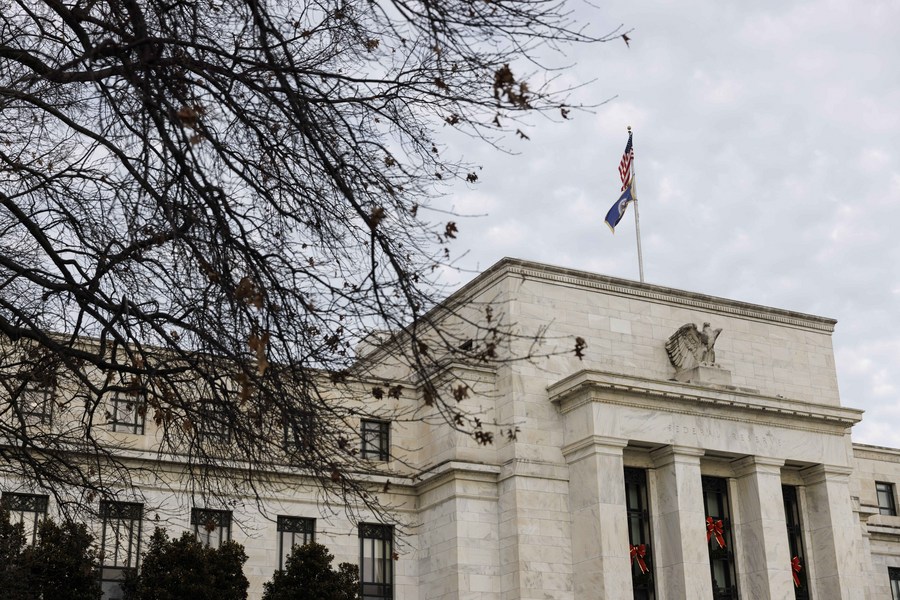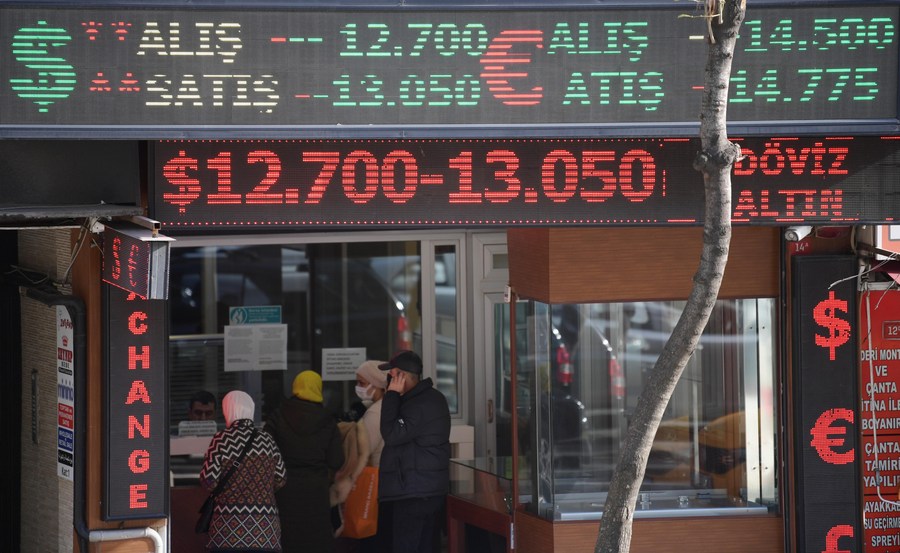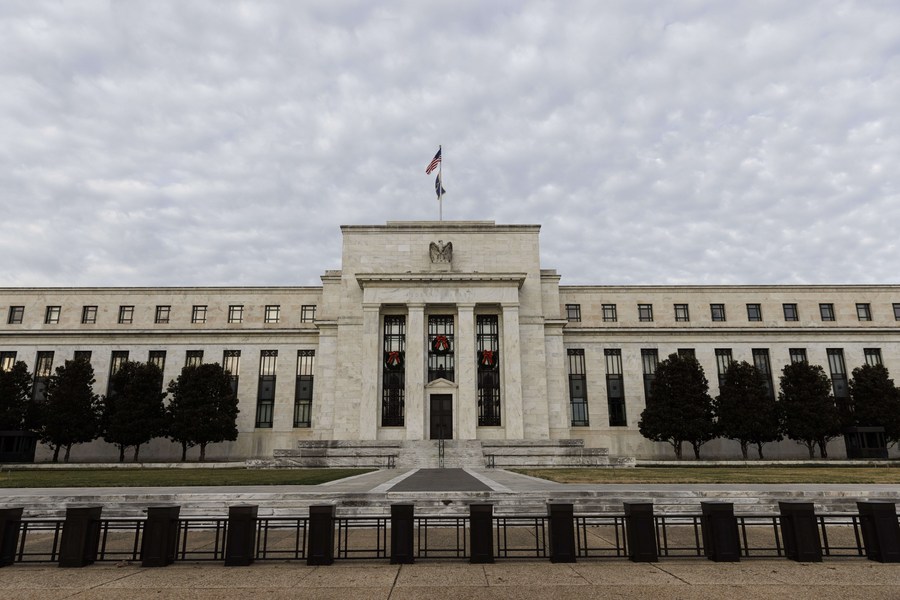-- The Fed is now on track to end its asset purchases by March, three months earlier than initially planned.
-- Projections showed that the central bank could raise the federal funds rate three times next year from its current record-low level of near zero.
-- Analysts found that financial spillovers to emerging markets from U.S. monetary policy depend on the drivers of higher yields and domestic conditions in emerging markets.

Photo taken on Dec. 15, 2021 shows the U.S. Federal Reserve in Washington, D.C., the United States. (Photo by Ting Shen/Xinhua)
WASHINGTON, Dec. 18 (Xinhua) -- The U.S. Federal Reserve has made a hawkish pivot to remove its pandemic-era monetary stimulus more quickly than previously expected in a bid to combat surging inflation.
While investors have begun preparing for the Fed to start raising interest rates next year, a faster tightening in U.S. monetary policy could push up global borrowing costs sharply and cause an adverse financial spillover to emerging markets and developing economies, particularly those with high debt levels, economists said.
HAWKISH PIVOT TO TAME INFLATION
The Fed on Wednesday laid out a plan to reduce its monthly asset purchases by 30 billion U.S. dollars starting in January, doubling the pace it announced a month earlier, in response to rising inflation pressures.
"We are phasing out our purchases more rapidly because with elevated inflation pressures and a rapidly strengthening labor market, the economy no longer needs increasing amounts of policy support," Fed Chairman Jerome Powell said Wednesday afternoon at a virtual press conference after wrapping up a two-day meeting.
"In addition, a quicker conclusion of our asset purchases will better position policy to address the full range of plausible economic outcomes," Powell said, noting the risk of higher inflation becoming entrenched "has increased."
The U.S. consumer price index rose 6.8 percent in November from a year earlier, the fastest annual pace in almost 40 years, according to the U.S. Labor Department.
The Fed is now on track to end its asset purchases by March, three months earlier than initially planned, as it exits from the ultra-loose monetary policy enacted at the start of the pandemic.
Meanwhile, Fed officials' median interest rate projections released Wednesday showed that the central bank could raise the federal funds rate -- the benchmark interest rate -- three times next year from its current record-low level of near zero.
That marks a major shift from the last time forecasts were updated in September, when 18 Fed officials were evenly split over the need to raise rates in 2022.
"The Fed has made a full pivot from viewing inflation as transitory to more persistent and problematic. The Fed is clearly worried about inflation becoming more entrenched," said Diane Swonk, chief economist at major accounting firm Grant Thornton, adding a more persistent inflation could justify even more rate hikes than the Fed has penciled in for the year.

A customer shops at a Target store in New York, the United States, Dec. 10, 2021. (Xinhua/Wang Ying)
However, it remains questionable whether the Fed's current policy shift is sufficient to bring U.S. inflation back toward the central bank's target of 2 percent, Desmond Lachman, resident fellow at the American Enterprise Institute and a former official at the International Monetary Fund, told Xinhua.
"U.S. monetary policy will remain excessively loose over the next few months. The Fed will still be buying bonds and interest rates will remain negative in inflation-adjusted terms," Lachman said.
"While I do believe that we will get some reduction in inflation as global supply chains are repaired, I do not believe that inflation will decline in 2022 to the 2.6 percent rate that the Fed is forecasting," he added.
Asked about whether the Fed is behind the curve on getting inflation under control, Powell said, "I think we're reacting to that now and we'll continue to adapt our policy."
"I would look at it that we're actually in position now to take the steps that we'll need to take, you know, in a thoughtful manner to address all of the issues, including that of too-high inflation," Powell told reporters.
U.S. annual inflation is expected to remain above the central bank's target of 2 percent over the next three years amid supply chain bottlenecks, rising wages and strong demand for goods and services, according to a survey recently released by the National Association for Business Economics.

People exchange money in an exchange office in Istanbul, Turkey, Nov. 30, 2021. (Xinhua/Shadati)
RISKS TO EMERGING MARKETS
Given the prospect for a faster Fed tapering and faster rate hikes, economists at Wells Fargo Securities led by Nick Bennenbroek forecast a stronger U.S. dollar against other currencies over the next two years.
"Tighter Fed monetary policy should keep downward pressure on most emerging currencies," which are generally more sensitive to rising U.S. bond yields, the economists said Friday in an analysis.
"Part of that sensitivity stems from the fact that higher yields in the U.S. dampen the 'reach for yield' mindset. As yields in the U.S. rise, the need for investors to search for higher returns in the emerging markets may dissipate," they explained.
"In addition, rising U.S. yields often pressure government financing costs. With some emerging market sovereigns already facing precarious public finance positions, elevated financing costs could place additional pressure on debt burdens and fiscal balances across the emerging markets," the economists said.
The yield on the benchmark 10-year U.S. Treasury note retreated from around 1.7 percent in late November to 1.4 percent on Friday, but higher than 0.9 percent at the start of the year.
Some emerging market currencies, including the Brazilian real, Turkish lira and South African rand, have already suffered sharp losses against a strengthening U.S. dollar in recent months.
A faster Fed tightening could further attract capital flows toward the U.S. dollar and away from emerging markets, analysts said.

Photo taken on Dec. 15, 2021 shows the U.S. Federal Reserve in Washington, D.C., the United States. (Photo by Ting Shen/Xinhua)
"We are already seeing capital flows to the emerging markets drying up on the expectation of higher U.S. interest rates next year," Lachman told Xinhua.
"If the Fed is forced to raise interest rates at a faster pace than presently planned, we must expect capital to be repatriated from the emerging markets. This could be problematic for many emerging market economies that have very high debt levels," Lachman said.
Non-resident portfolio flows into non-China emerging markets have turned slightly negative during the current quarter, according to the high-frequency tracking data recently released by the Washington-based Institute of International Finance.
In a research note published in June, Jasper Hoek and Emre Yoldas, economists at the Fed Board, found that financial spillovers to emerging markets from U.S. monetary policy depend on the drivers of higher yields and domestic conditions in emerging markets.
A rise in U.S. interest rates driven by favorable growth prospects is likely to have relatively benign effects on emerging financial markets, as a stronger U.S. economy would increase imports from its trading partners and boost investor confidence, the economists said.

A house on sale is seen in Washington D.C., the United States, Dec. 12, 2021. (Photo by Ting Shen/Xinhua)
However, if higher rates are driven mainly by worries about U.S. inflation or a hawkish turn in Fed policy, it will likely be "more disruptive" for emerging markets, they noted.
"The recent surge in inflation will require higher rates, and the Fed clearly thinks that its work will not be done in the near term and will require sustained attention over the next three years," said Joseph Brusuelas, chief economist at accounting and consulting firm RSM US LLP, anticipating a series of rate hikes through the end of 2024.
(Video reporter: Hu Yousong; Video editors: Zhang Yucheng, Li Qin)■




